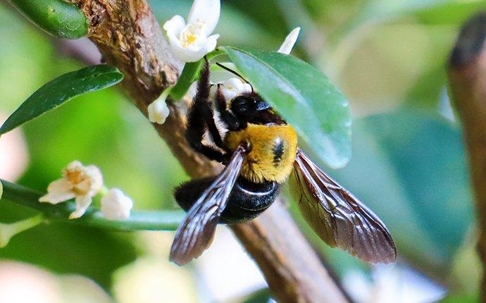Few home or business owners in the Bay Area are pest specialists. However, they might have an understanding of key facts related to common invading pests. When it comes to bees, the average person knows that they produce honey. Another widely spread detail is that the bugs tend to surround plants and flowers and help sustain the balance of the environment. Their feeding patterns also contribute. Last, but not least, the majority of folks know that bees give out painful stings. Even with all that said, that isn’t the total of vital information.
Some species are particularly dangerous, and carpenter bees are an example. They can wreck wood, and take down a whole building. You have to learn more about these flying insects, so you can protect your property. Find out what peril they bring, and how Bay Pest can get rid of them.
How Do Carpenter Bees Operate? What Are the Risks?
Not all carpenter bees are the same size and color. Those in the smaller subset are about 0.31 of an inch long. Yellow markings adorn their dark metallic skin. Larger ones are 0.46 to 0.98 of an inch long. While many are purple-blue or plain blue, lots are greenish-black or black. Males are distinguished by the yellow blots on their faces; they can’t sting at all. People tend to confuse carpenter bees with their bumblebee relatives, but they have less body hair.
Unfinished or weathered wood is the target of carpenter bees. This is particularly true if the kind is cyprus, pine, redwood, oak, or fir. If these buzzing bugs aren’t hovering over greenery for nectar, they’ll be gathering by porches and decks, window sills, doors, roof eaves, and siding. Keep an eye on your yard furniture, fences, and railings as well. Damages will eventually be visible, but until then, take note of these infestation signs:
- Discovering needle-point holes in wood and foundations
- Seeing fecal grains and stains near their entry pockets
- Noticing masses of sawdust and pollen beneath their gaps
- Catching carpenter bees fluttering about
- Having abrupt woodpecker sightings; they go after carpenter bee larvae
Are There Ways to Prevent Carpenter Bees?
Carpenter bees are only a threat to you if you have a significant allergy to the toxins of stinging insects. Other than that, these pests will be more harmful to wood, domiciles, and establishments. They can be so ruinous, that pricey repairs may be needed. To avoid them, you must be diligent with preventative protocols, which include meticulous exterior management. The insects build nests constantly. Here’s what you’ll have to do:
- Paint unfinished wood right away. Add a fresh coat to weathered sills and decks.
- Varnish wood that will be exposed to inclement conditions, rainwater, and sun.
- Seal crevices in rooflines, windows, doors, and foundations.
- Close up voids that prior carpenter bees have left. You can try using caulk.
- Lessen any standing water on your property.
- Repair leaks and moisture problems immediately.
- Have metal flashing installed.
- Mow the lawn and trim greenery often. Make sure flowers and plants are at least two feet away.
How Will Bay Pest Handle Carpenter Bees?
Don’t take a chance going near bees or their nests. You could be stung by multiple insects, many times. You may feel more confident if you have an insecticide in your hand, but these products give a false sense of comfort. They can irritate the bugs, or cause them to spread out. Instead, reach out to us at Bay Pest. Our seasoned technicians will employ high-quality treatments you can’t find elsewhere. These solutions will be safe for you, others, pets, and vegetation. Call today and get a free estimate!

